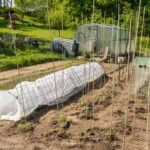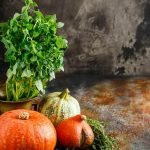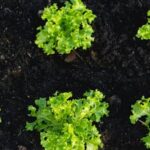Are you interested in growing your own vegetables but lack the space for a traditional garden? Look no further than vegetable container gardens. Container gardening has become increasingly popular, especially for those living in small spaces or urban environments. In this article, we will explore the concept of vegetable container gardens and their numerous benefits for individuals looking to cultivate their own produce.
When it comes to vegetable container gardens, selecting the right containers is crucial. From pots and grow bags to raised beds, there are various options available to suit different needs and preferences. Factors such as size, material, and drainage must be considered when choosing containers for successful vegetable gardening.
One of the key elements in achieving a thriving vegetable container garden is selecting the best vegetables that are well-suited for this type of cultivation. Certain plants such as tomatoes, peppers, lettuce, and herbs thrive exceptionally well in containers. Choosing the right varieties and understanding their specific needs is essential for a successful harvest.
Selecting the Right Containers
When it comes to growing vegetables in small spaces or urban environments, vegetable container gardens are a great option. The first step in creating a successful vegetable container garden is selecting the right containers. There are several types of containers suitable for vegetable gardening, each with its own benefits and considerations.
Here are some options for containers suitable for vegetable container gardens:
- Pots: Traditional clay or plastic pots are popular choices for growing vegetables in containers. They come in various sizes and are easily movable, making them ideal for smaller spaces.
- Grow Bags: These lightweight, breathable bags are an excellent choice for growing vegetables in a container garden. They provide good drainage and air circulation for the roots of the plants.
- Raised Beds: Raised bed planters provide a deep growing space for vegetables and allow for better root development. They also offer good drainage and can be easier to maintain than traditional in-ground gardens.
When choosing containers for vegetable gardening, it’s essential to consider factors such as size, material, drainage, and mobility. The size of the container will depend on the specific vegetables you want to grow, as some plants require more space than others. Additionally, considering the material of the container is crucial as it can affect soil temperature and moisture retention.
Proper drainage is also important to prevent waterlogged soil, which can lead to root rot and other issues. Lastly, consider the mobility of your containers if you plan on moving them around to maximize sunlight exposure or protect them from inclement weather.
Overall, selecting the right containers is a critical first step in creating a thriving vegetable container garden. By carefully considering your options and choosing containers that meet the needs of your chosen vegetables, you can set yourself up for success in growing delicious produce in limited spaces.
Choosing the Best Vegetables for Container Gardens
Top Vegetables for Container Gardens
When it comes to choosing the best vegetables for your container garden, it’s essential to select varieties that are well-suited for the limited space and growing conditions. Some of the top vegetables that thrive in container gardens include tomatoes, peppers, lettuce, and herbs. These plants don’t require a large root system and can be grown successfully in pots, grow bags, or raised beds.
Tips for Selecting the Best Varieties
When selecting vegetable varieties for your container garden, consider choosing compact or dwarf cultivars that are specifically bred for small-space gardening. For tomatoes, look for determinate varieties that produce a more contained plant size. When it comes to peppers, opt for compact bush-type varieties that are ideal for containers. Additionally, choose loose-leaf lettuce varieties that are perfect for continuous harvesting in small spaces. For herbs, consider growing compact plants like basil, chives, and thyme.
Other Considerations
Apart from the specific plant varieties, it’s crucial to consider the climate and microclimate of your growing area when selecting vegetables for your container garden. Some plants may require more sunlight or have specific temperature preferences. It’s also important to assess the space available in your containers and plan accordingly to ensure proper growth and productivity of your vegetable crops.
Overall,careful selection of vegetable varieties is key to successful vegetable container gardening. By choosing the right plants tailored to small-space growing conditions, you can enjoy a bountiful harvest from your own urban or small-space garden setup.
Preparing the Soil
When it comes to vegetable container gardens, one of the most crucial elements for success is the quality of the soil. Unlike traditional in-ground gardening, container gardening relies entirely on the soil mix within the container to provide nutrients, air, and moisture to the plants. Therefore, selecting and preparing the right soil mix is essential for optimal plant growth and productivity.
Here are some key factors to consider when preparing the soil for your vegetable container garden:
- Soil Mix Components: A good soil mix for vegetable container gardens should be well-draining, lightweight, and rich in organic matter. Consider using a combination of ingredients such as peat moss, perlite or vermiculite, compost, and coarse sand. These components help create a balanced environment for roots to thrive.
- Nutrient Content: Since container plants rely solely on the nutrients present in the soil mix, it’s important to ensure that the soil is rich in essential nutrients. You can add slow-release organic fertilizers or compost to supply a steady source of nutrients throughout the growing season.
- pH Levels: Different vegetables have varying preferences when it comes to pH levels in the soil. Conduct a simple soil test to determine the pH of your soil mix and make adjustments as needed. Most vegetables prefer a slightly acidic to neutral pH range.
By paying attention to these factors and creating a well-balanced soil mix, you can provide an ideal growing environment for your vegetable container garden. Remember that healthy soil leads to healthy plants, which ultimately results in a bountiful harvest of delicious home-grown vegetables.
Planting and Maintenance
When starting a vegetable container garden, it’s essential to ensure that you are planting and maintaining your vegetables properly in order to yield a successful and bountiful harvest. The first step is to choose the right containers for your specific vegetables.
Pots, grow bags, and raised beds are all viable options for container gardening, and each has its own set of benefits. Consider the space you have available, the type of vegetables you want to grow, and the aesthetic you are aiming for when selecting your containers.
Once you’ve chosen your containers, it’s crucial to fill them with high-quality soil that is suitable for vegetable growth. A well-draining potting mix that is rich in organic matter will provide the necessary nutrients for your plants to thrive.
Additionally, it’s important to pay attention to proper watering techniques and fertilization schedules. Vegetables grown in containers require more frequent watering than those planted in traditional gardens due to their limited soil volume, so be sure to monitor the moisture levels closely.
Spacing is another key factor in successful vegetable container gardening. Overcrowding can lead to competition for nutrients and limited airflow, resulting in stunted growth and increased susceptibility to pests and diseases. Follow spacing guidelines provided on seed packets or plant tags to ensure that each plant has adequate room to grow.
With proper care and maintenance, your vegetable container garden can flourish and provide a plentiful harvest of delicious homegrown produce.
| Container Types | Advantages |
|---|---|
| Pots | Portable, easy to manage |
| Grow Bags | Affordable, good drainage |
| Raised Beds | Deeper soil depth, less bending required |
Pests and Disease Management
Vegetable container gardens are a convenient and practical way to grow your own produce, but like traditional gardens, they can be susceptible to pests and diseases. These issues may arise due to various factors such as environmental conditions, poor soil quality, or lack of proper maintenance. However, with the right strategies and organic solutions, you can effectively manage these challenges and protect your container-grown vegetables.
One common pest that can affect vegetable container gardens is aphids. These small insects feed on plant sap and can quickly multiply, causing damage to the foliage and spreading diseases. To prevent aphid infestations, consider introducing beneficial insects like ladybugs or lacewings to your garden. Additionally, you can use insecticidal soap or neem oil as organic remedies to control aphids without harming the plants or the environment.
Another issue that container gardeners may encounter is fungal diseases such as powdery mildew or blight. These diseases thrive in humid conditions and can spread rapidly if left untreated. To prevent fungal infections, it is important to provide adequate air circulation around your plants by properly spacing them in their containers. In addition, applying a preventive spray of diluted baking soda or a homemade compost tea can help suppress fungal growth and keep your vegetable garden healthy.
In summary, maintaining a healthy vegetable container garden involves being proactive in preventing and managing pests and diseases using environmentally friendly methods. By implementing these organic solutions for pest and disease management, you can enjoy a thriving container garden filled with delicious homegrown vegetables.
| Pest/Disease | Organic Solution |
|---|---|
| Aphids | Introduce beneficial insects or use insecticidal soap/neem oil |
| Fungal Diseases (powdery mildew/blight) | Provide air circulation; apply preventive spray of diluted baking soda or compost tea |
Harvesting and Storage
Harvesting Techniques
When it comes to harvesting vegetables from your container garden, timing is crucial. Each type of vegetable has its own specific signs that indicate it’s ready for harvest.
For example, tomatoes should be picked when they are fully colored and slightly soft to the touch, while lettuce can be harvested by cutting leaves from the outer portion of the plant as needed. It’s important to familiarize yourself with the ideal harvesting times for the vegetables you are growing in order to enjoy the best flavor and quality.
Another key factor in harvesting from your vegetable container garden is using the right tools and techniques. Sharp pruners or scissors are essential for cleanly cutting crops like herbs or leafy greens, while some root vegetables may require gently loosening the soil around them before pulling them up. By implementing proper harvesting techniques, you can ensure minimal damage to your plants and a bountiful, satisfying harvest.
Storing and Preserving
Once you’ve harvested your homegrown produce, it’s important to store and preserve it properly to make the most of your efforts. Many vegetables from a container garden have a relatively short shelf life compared to commercially grown options, so it’s essential to handle them carefully after picking. For instance, tomatoes should be stored at room temperature until fully ripe, then moved to the refrigerator if not used promptly.
Proper storage containers can also make a big difference in preserving your harvest. For certain vegetables such as root crops or winter squash, cool dark spaces like basements or refrigerators are ideal for long-term storage. Freezing or canning excess produce can also extend their usability well beyond their natural seasons. By following these tips for storing and preserving harvested vegetables from a container garden, you can continue enjoying their fresh flavors long after they’ve been picked.
Tips for Long-Term Enjoyment
To lengthen your enjoyment of homegrown container-grown vegetables even further, consider exploring various preservation methods such as pickling, fermenting, or making preserves and sauces. This will allow you to savor your hard-earned produce throughout different seasons or share them with friends and family.
Additionally, saving seeds from some of your favorite plants will enable you to grow them again next year without having to purchase new seeds. By taking advantage of these strategies for long-term enjoyment, you can truly maximize the rewards of growing veggies in containers while minimizing food waste at the same time.
Success Stories and Tips From Experienced Gardeners
In conclusion, vegetable container gardens offer a practical and fruitful way for individuals with limited space to grow their own fresh produce. With the right containers, soil, and plant selection, anyone can enjoy a bountiful harvest from their balcony, patio, or even windowsill. The benefits of vegetable container gardening go beyond just providing homegrown food; it also offers therapeutic benefits and a sense of accomplishment.
Whether it’s a small pot of herbs or a collection of various vegetables in larger containers, the possibilities for vegetable container gardens are endless. With proper care and maintenance, anyone can enjoy the rewards of growing their own vegetables right at home. Additionally, learning from experienced gardeners who have successfully grown vegetables in containers can provide valuable insights and practical tips for beginners.
As more people become interested in sustainable living and self-sufficiency, vegetable container gardens will continue to be an accessible and rewarding option for urban dwellers and those with limited outdoor space. By following the advice of experienced container gardeners and remaining attentive to the needs of the plants, anyone can create their own thriving vegetable container garden.
The satisfaction of harvesting and enjoying homegrown vegetables is truly unmatched. Whether it’s a small balcony or a spacious patio, there is always room to grow something green and delicious in a vegetable container garden.
Frequently Asked Questions
What Vegetables Work Well in Container Gardens?
Many vegetables work well in container gardens, including tomatoes, peppers, lettuce, spinach, kale, carrots, radishes, and herbs like basil and parsley. These plants thrive in the confined space of a container and can be easily managed.
What Vegetables Can You Grow Together in a Container?
There are several vegetables that can be grown together in a container garden. For example, you can plant tomatoes with basil or peppers with onions. These combinations not only save space but they also complement each other’s growth conditions.
What Is the Best Container for a Vegetable Garden?
The best container for a vegetable garden is one that provides enough room for the plant to grow and has good drainage. Options include plastic or wooden containers, fabric pots, or self-watering containers. It’s important to choose a container that suits the specific needs of your chosen vegetables.

If you’re looking to get into vegetable gardening, or are just looking for some tips on how to make your current garden better, then you’ve come to the right place! My name is Ethel and I have been gardening for years. In this blog, I’m going to share with you some of my best tips on how to create a successful vegetable garden.





